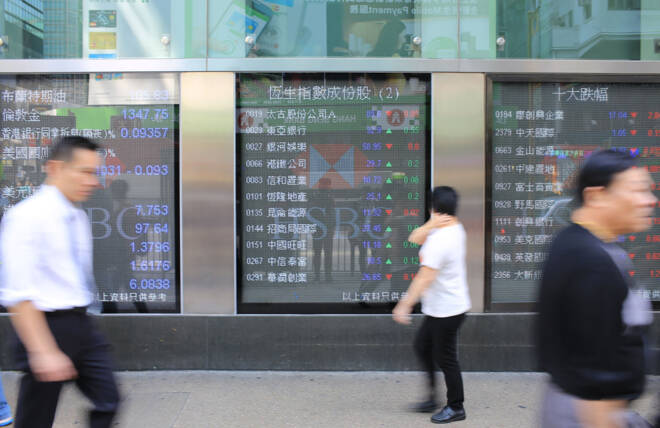Advertisement
Advertisement
Hang Seng Index, ASX 200, Nikkei 225 Index: Rally, Rebound, and Reversal: A Mixed Forecast for Asia
By:
Economic forecasts weigh heavily on global indices, with the ASX 200 and Hang Seng revealing resilience and revival amidst market uncertainties.
Key Insights:
- The Hang Seng Index rallied on anticipated Beijing stimulus on Friday; the Nikkei, in contrast, saw red.
- Investors eye China for economic reforms, amidst fluctuating global market sentiments.
- Market sentiments are tested by predictions of sustained high-interest rates.
Overview of the Friday Session
On Friday, the Hang Seng Index enjoyed a breakout session, with the ASX 200 recovering from early losses. However, the Nikkei bucked the end-of-week trend.
US economic indicators from Thursday weighed on market risk appetite early in the Asian session on Friday. A drop in initial jobless claims from 221k to 201k supported the upbeat FOMC economic projections and a more aggressive Fed interest rate path.
The US equity markets set the tone for the Friday session. On Thursday, the S&P 500 and the Dow saw losses of 1.64% and 1.08%, respectively. The NASDAQ Composite Index slid by 1.82%.
The Bank of Japan delivered its monetary policy decision on Friday, leaving interest rates and yield control curve policy unchanged. A sliding Yen fueled fears of a government intervention to bolster the Yen, pressuring the Nikkei.
Disappointing private sector PMI numbers from Japan added to the gloomy mood. The services PMI fell from 54.3 to 53.3 in September, with the manufacturing PMI down from 49.6 to 48.6.
In contrast, the Hang Seng Index rallied on hopes of fresh stimulus measures from Beijing to boost the Chinese economy. The ASX 200 responded to the Hang Seng Index moves, reversing heavier losses from the session, with tech stocks bouncing back.
Higher for Longer Interest Rate Outlook to Test Buyers
Economic indicators from the US failed to support the US equity markets on Friday. The US services PMI declined from 50.5 to 50.2, while the manufacturing PMI rose from 47.9 to 48.9. Avoiding a contraction across the services sector was enough for investors betting on a more aggressive Fed interest rate path.
The threat of a US government shutdown added to the risk-off mood.
On Friday, the NASDAQ slipped by 0.09%, with the Dow and S&P 500 falling by 0.31% and 0.23%, respectively. The negative sentiment from Friday will likely spill over to the Asian session on Monday.
Market sentiment toward a higher-for-longer interest rate environment will continue to test the appetite for riskier assets. However, investors will need to consider updates from China on economic reform plans. Looking at the Futures Markets, the ASX 200 and Nikkei were down 18 and 130 points, respectively.
ASX 200
The ASX 200 rose by 0.05% on Friday. Tech stocks struggled for the fifth consecutive day. The S&P/ASX All Technology Index (XTX) fell by 0.55%. However, mining and the big four banks had mixed sessions.
BHP Group Ltd (BHP) and Fortescue Metals Group (FMG) saw gains of 0.54% and 1.46%, respectively. Newcrest Mining (NCM) rose by 0.07%, while Rio Tinto (RIO) fell by 1.15%.
The National Australia Bank (NAB) and Westpac Banking Corp (WBC) ended the day up by 0.45% and 0.71%, respectively. However, ANZ Group (ANZ) and the Commonwealth Bank of Australia (CBA) saw losses of 0.08% and 0.02%, respectively.
Oil stocks found much-needed support. Woodside Energy Group (WDS) and Santos Ltd (STO) ended the day with gains of 0.58% and 0.66%, respectively.
Hang Seng Index
The Hang Seng Index rallied 2.28%. News of the US and China setting up working groups to improve relations contributed to the positive session.
Alibaba Group Holding Ltd (HK:9988) and Tencent Holdings Ltd (HK:0700) jumped by 3.93% and 3.50%, respectively.
Bank stocks also enjoyed a positive session. China Construction Bank (HK:0939) and the Industrial and Commercial Bank of China (HK:1398) rose by 1.13% and 1.33%, respectively. HSBC Holdings PLC (HK:0005) ended the day up 0.99%.
Nikkei 225
(Graph for reference purposes only)
The Nikkei 225 declined by 0.52% on Friday.
Sumitomo Mitsui Financial Group (8316) and Mitsubishi UFJ Financial Group rose by 1.14% and 0.99%, respectively.
However, the main components had a mixed session.
Sony Corp. (6758) and SoftBank Group Corp. (9984) declined by 0.97% and 0.94%, respectively.
Tokyo Electron Limited (8035) and Fast Retailing Co (9983) ended the session down 0.44% and 0.87%, respectively. KDDI Corp. (9433) bucked the trend, gaining 0.15%.
For upcoming economic events, check out our economic calendar.
About the Author
Bob Masonauthor
With over 28 years of experience in the financial industry, Bob has worked with various global rating agencies and multinational banks. Currently he is covering currencies, commodities, alternative asset classes and global equities, focusing mostly on European and Asian markets.
Did you find this article useful?
Latest news and analysis
Advertisement
